Email Marketing for Real Estate A Proven Guide
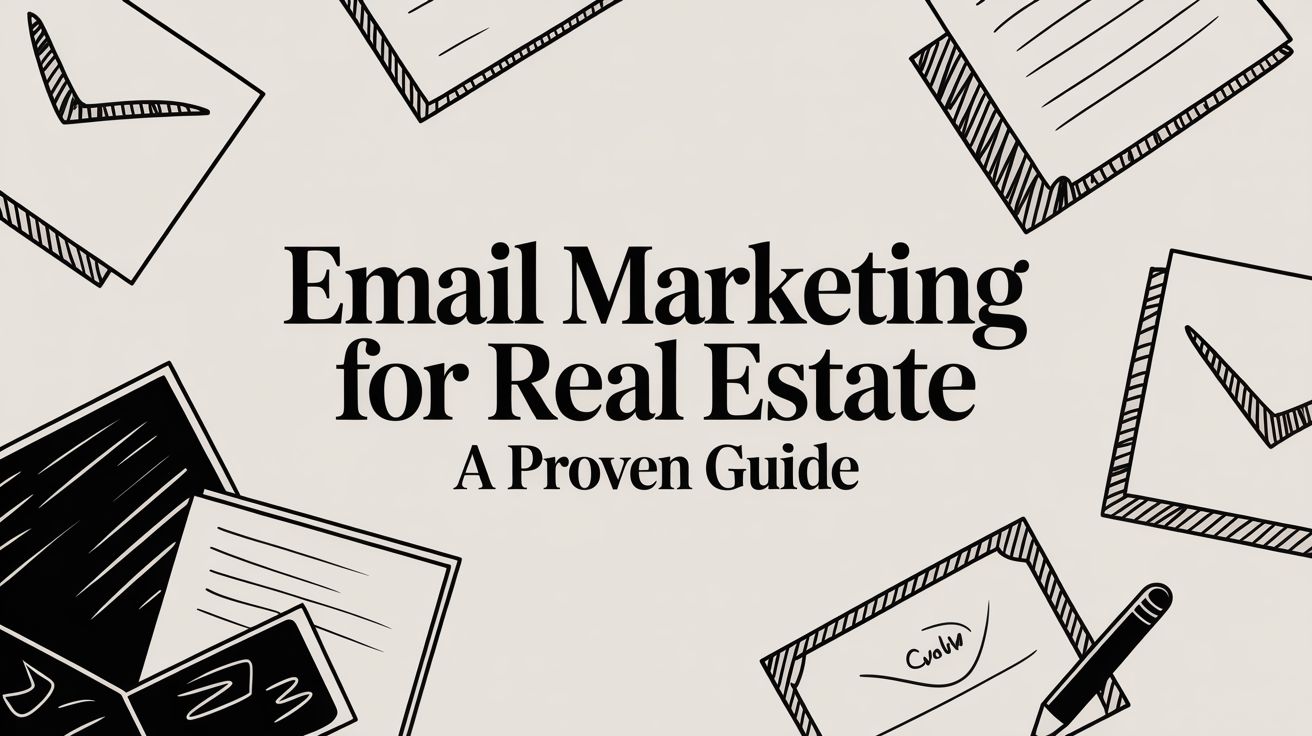
When it comes to real estate marketing, email isn't just another tool—it's your most profitable one. It's how you build direct, lasting relationships with clients, nurture leads who aren't ready to buy today, and stay top-of-mind so you're the first person they call when they are ready.
Unlike the ever-changing whims of social media algorithms, your email list is a channel you own and control. The secret? Stop just sending listings. Start delivering valuable, targeted content that genuinely helps people navigate the twists and turns of buying or selling a home.
Why Email Is Your Most Valuable Marketing Tool
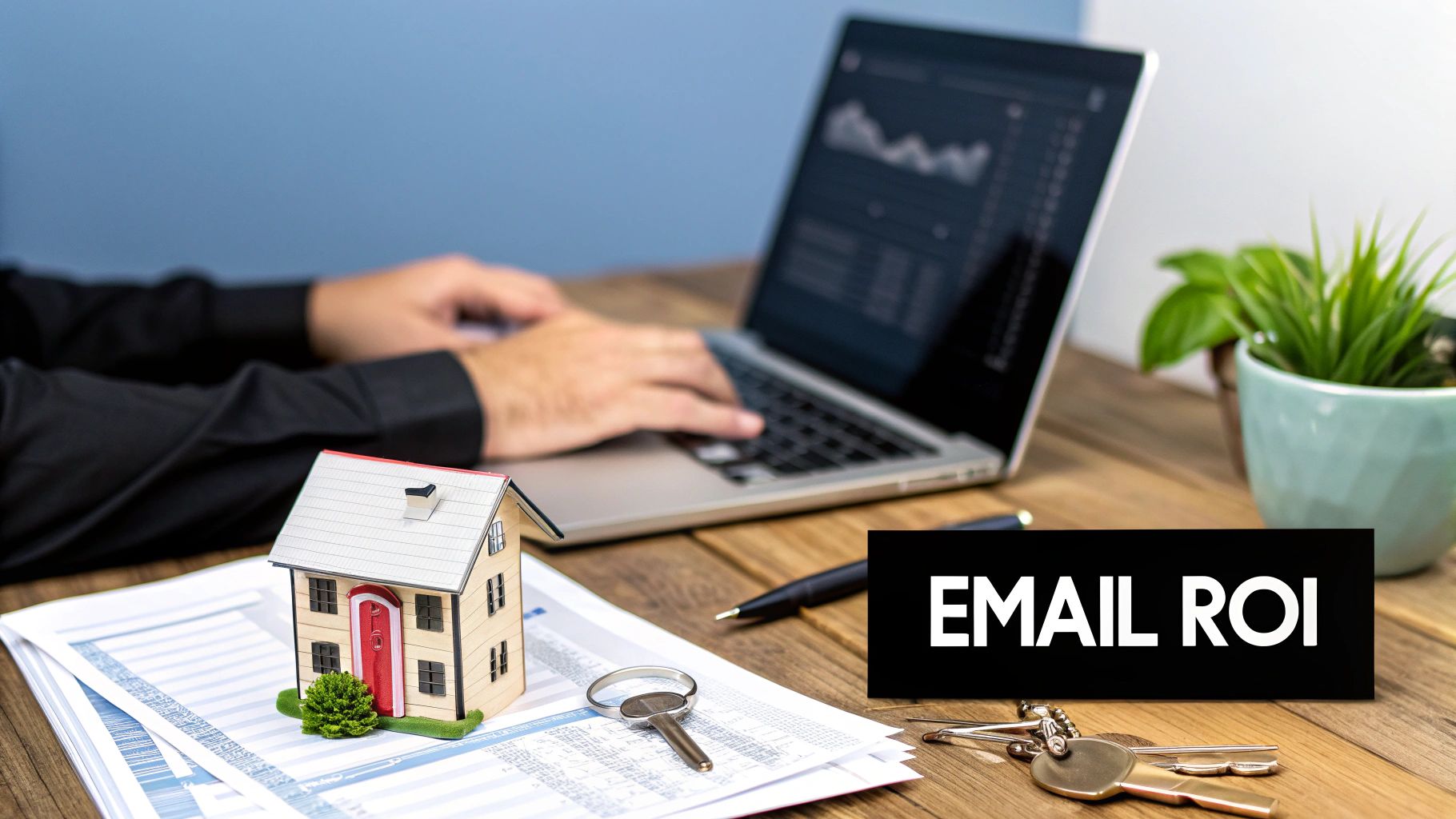
Social media gets all the hype, but email is still the most reliable and direct line you have to your audience. Think about it: an email inbox is a personal space. When someone gives you their email address, they're giving you permission to connect with them directly. That's a huge sign of trust, and it’s an opportunity you can’t afford to waste.
This direct connection is your chance to become more than just another agent in their inbox. You become the go-to local expert who sends timely market updates, helpful home maintenance tips, and insider knowledge they can't get anywhere else.
The Unbeatable ROI of Real Estate Emails
Let's cut to the chase and talk numbers, because the return on a solid email strategy is staggering. Email marketing in real estate delivers one of the most impressive ROIs out there. For every $1 you put in, you can expect an average return of around $36. That's a 3,600% ROI.
And when it comes to turning leads into clients, email is a powerhouse, performing 40% better than social media channels.
Why is it so effective? Because email is built for the long game. The person who visited your open house last weekend might not be ready to make a move for another six or twelve months. Consistent, helpful emails keep you on their radar, building a relationship so that when they're ready, you're the only agent they think of.
"Email marketing isn't just about sending listings. It's about creating a system of trust. Each email is a touchpoint that reinforces your expertise and demonstrates your commitment to helping clients, long before a transaction ever happens."
This approach turns your marketing from a series of disjointed efforts into a well-oiled machine that consistently generates new business and referrals. If you want to dig deeper into proven strategies for lead nurturing and automation, this comprehensive guide to email marketing in real estate is a fantastic resource.
Building Your Digital Foundation
Your email list is your own private marketing asset. It’s a database of prospects, current clients, and past clients that belongs to you, not a social media giant. This independence is what builds a resilient business that can weather any storm.
A strong email strategy becomes the engine for your entire business, helping you:
- Drive traffic to your new listings and blog posts.
- Promote open houses to a targeted, interested audience.
- Gather testimonials from thrilled past clients.
- Generate referrals by staying connected with your sphere of influence.
At the end of the day, effective email marketing for real estate is about playing the long game. It works quietly in the background, building the relationships that will ensure your business thrives, no matter what the market is doing.
How to Build an Email List That Actually Converts
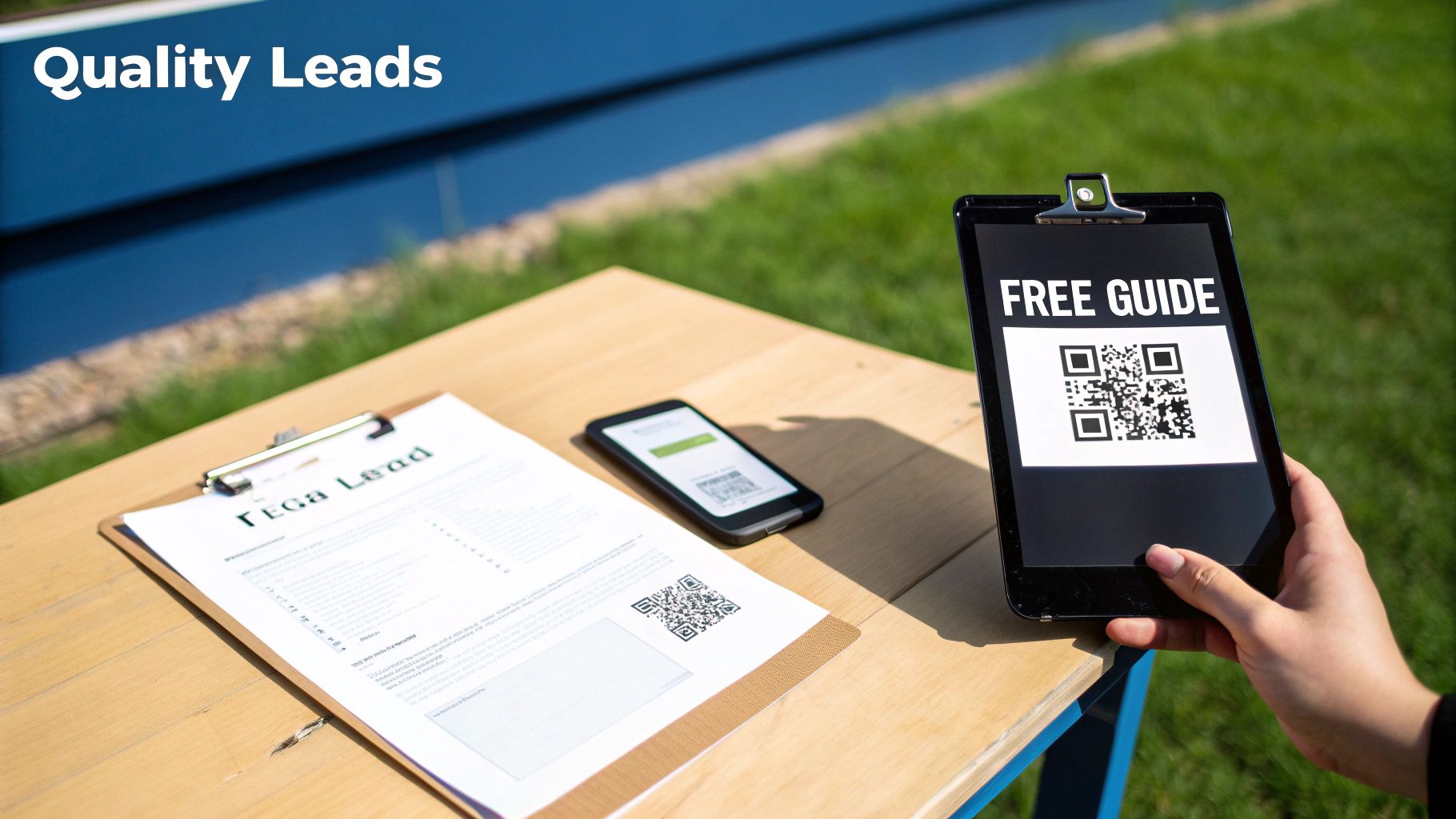
Let's be honest: an email list is useless if it's full of people who don't want to hear from you. The foundation of successful email marketing for real estate isn't about how big your list is, but how good it is. Forget about buying lists—that’s a one-way ticket to the spam folder and a quick way to tank your reputation.
The real goal is to build a list of genuinely interested people who actually look forward to your emails. This starts with a simple mindset shift: stop "collecting emails" and start "earning permission."
Create Irresistible Lead Magnets
A lead magnet is just a fancy term for a valuable freebie you offer in exchange for an email address. This isn’t about a generic "sign up for my newsletter" button. It’s about offering a specific solution to a real problem your ideal client is facing right now.
Think about what keeps buyers and sellers in your area up at night. What information would give them immediate relief or clarity? That's your lead magnet.
- For Sellers: Create a "Seller's Pre-Listing Checklist" that walks them through exactly how to prep a home for the market in your city.
- For Buyers: Offer a "Neighborhood Amenities Guide" comparing local parks, schools, and coffee shops in the areas they're searching.
- For First-Time Buyers: A "Home Loan Pre-Approval Kit" with a checklist of required documents and your top local lender recommendations is pure gold.
These resources work because they deliver instant value. You’re positioned as a helpful expert before you ever talk about a specific property.
The best lead magnets solve a small but significant problem. They offer a quick win that builds trust and showcases your expertise from the very first click.
Turn Your Website into a Lead Capture Hub
Your website is prime real estate for growing your list. Most people who visit your site will leave without ever contacting you. Your job is to give them a compelling reason to connect before they go.
Don't just bury a sign-up form in your footer and hope for the best.
Get strategic with your opt-in forms. Place them where visitors are most engaged, like within a blog post about local market trends or as a pop-up offering a helpful guide when they're about to leave the site.
Even better, create a dedicated landing page for each lead magnet. This is a simple, no-fluff page with one single purpose: convincing visitors to download your resource. For example, if you write a blog post about crafting great listing descriptions, you can link it to a landing page with a downloadable template. To get a feel for what grabs a buyer's attention, take a look at these powerful property description samples.
Maximize Your In-Person Interactions
Every open house, community event, or client meeting is an opportunity. But please, ditch the paper sign-in sheet. It’s messy, inefficient, and screams outdated. Switch to a digital sign-in app on a tablet.
Here's why this is a non-negotiable upgrade:
- It's Professional: A sleek digital form makes a much better first impression than a crumpled clipboard.
- It's Legible: Finally, no more trying to decipher sloppy handwriting.
- It's Automated: Most apps integrate directly with your email marketing platform, automatically adding new contacts and saving you a ton of manual data entry.
When visitors sign in, be upfront. Tell them you'll be sending over the property details along with other relevant listings. This sets clear expectations and gets their explicit permission, starting the relationship off on the right foot. Every contact you add this way is a warm, qualified lead who actually expects to hear from you.
Using Smart Segmentation to Build Relationships
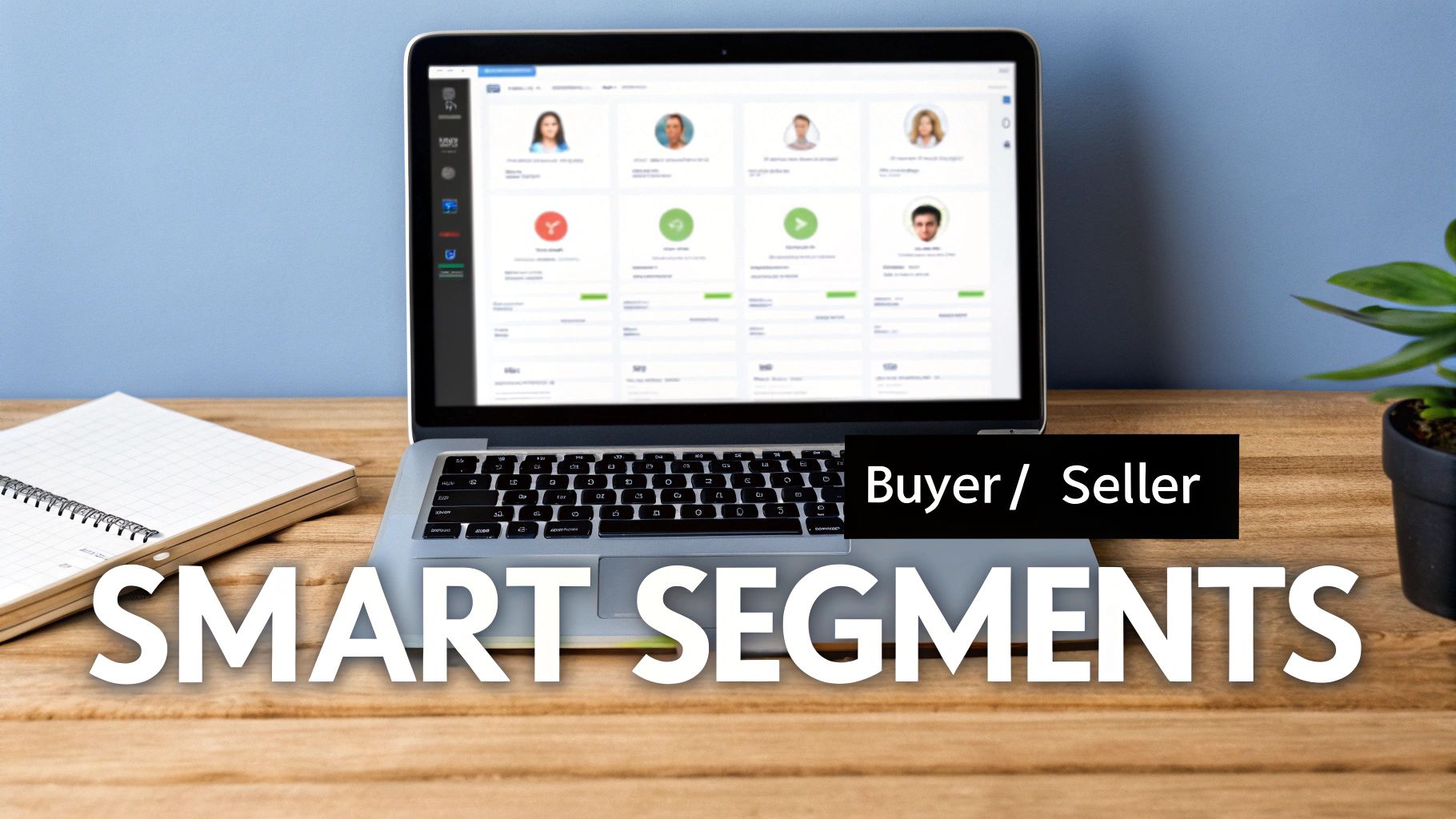
If you're sending the same generic newsletter to every single person on your list, you're leaving money on the table. It’s a huge missed opportunity. Real estate is intensely personal, and your email marketing absolutely has to reflect that.
The real secret to turning a basic contact list into a powerful relationship-building engine is smart segmentation. It's just a fancy way of saying you need to divide your audience into smaller, more specific groups based on who they are and what they need.
By doing this, you can finally stop broadcasting and start having real conversations. Instead of a single message that’s so general it doesn't truly connect with anyone, you can send super-relevant content that speaks directly to a person's goals. It’s the difference between shouting with a megaphone and having a one-on-one chat over coffee.
Identifying Your Core Audience Segments
First things first, you need to figure out the logical groups that already exist within your database. Every agent's list is a little different, but most of us are dealing with the same core types of clients. The goal here is simple: move beyond one giant "master list" and create targeted sub-groups.
Just think about the different people you talk to every day. You'd never use the same pitch or share the same stats with a nervous first-time buyer that you would with a seasoned property investor, right? Your emails should work the same way.
Here are the most common and effective segments I see successful agents using:
- First-Time Homebuyers: This group is often overwhelmed and hungry for guidance. They need you to break things down with step-by-step guides on getting pre-approved, navigating inspections, and understanding all that closing paperwork.
- Potential Sellers: These folks are laser-focused on one thing: getting the most for their home. They'll devour content about current market trends, home staging hacks, and—most importantly—recent comparable sales in their own neighborhood.
- Luxury Property Seekers: This segment isn't just buying a house; they're buying a lifestyle. They expect a premium experience and are interested in exclusive listings, high-end design trends, and deep dives into neighborhood amenities.
- Past Clients (Homeowners): Don't ever forget about the people you've already closed deals with! This group is your single best source for referrals. Keep them engaged with helpful home maintenance tips, local event calendars, and an annual market report for their area.
- Real Estate Investors: Investors are all about the numbers. They want to see cold, hard data on rental yields, property appreciation rates, and which up-and-coming areas have the most growth potential.
Segmentation is really just about empathy. It's about understanding that a first-time buyer's anxieties are completely different from a potential seller's financial goals. When your email acknowledges their unique perspective, you build instant trust.
Using Behavior to Drive Deeper Segmentation
Beyond these basic categories, the most effective email marketing for real estate uses subscriber behavior to get even more granular. Most modern email platforms, like Mailchimp or Constant Contact, can track how people interact with your website and emails, giving you incredible insights.
For instance, you can automatically tag subscribers based on what they do. If someone keeps clicking on listings in a specific school district, you can tag them as "Interested in Northwood District." A contact who downloads your "Seller's Pre-Listing Guide" should immediately be moved into your "Potential Sellers" group.
This dynamic approach means your follow-up can be incredibly timely and relevant.
To help visualize this, here’s a quick breakdown of how you can tailor your content to different groups.
Real Estate Email Segmentation Strategies
| Audience Segment | Example Content | Primary Goal |
|---|---|---|
| First-Time Homebuyers | "5 Common Mistakes to Avoid When Getting a Mortgage" | Educate and Build Trust |
| Potential Sellers | A hyper-local market report for their specific zip code | Demonstrate Expertise |
| Luxury Buyers | An exclusive preview of an off-market luxury listing | Create Exclusivity |
| Past Clients | "Your Annual Home Equity & Neighborhood Update" | Nurture for Referrals |
| Investors | "Top 3 Neighborhoods for Rental ROI in 2025" | Provide Actionable Data |
This table shows how a simple shift in content can directly address the unique motivations of each segment, making your emails far more effective.
Putting Segmentation into Action
Once your segments are set up, the real fun begins. Your weekly newsletter, for example, should now have a few different versions. The main message might be the same, but you can swap out certain sections to appeal to each group.
The "Featured Listing" you show to first-time buyers might be a perfect starter home, while the one for your luxury list is a sprawling modern estate.
This level of personalization sends a clear message: you're paying attention. You're not just another agent blasting out generic updates; you're a trusted advisor providing information curated just for them. This is how you cut through the inbox noise, get more opens and clicks, and build the kind of loyalty that leads to closed deals and clients for life.
How to Write Emails People Actually Want to Read
Let's be honest. Every email you send lands in a ridiculously crowded inbox. You're up against dozens, if not hundreds, of other messages all fighting for a sliver of your client's attention. So, how do you cut through all that noise?
The secret isn't some flashy template or stuffing your message with industry jargon. It's much simpler: shift your mindset from selling to serving.
Your real goal is to become that one person whose emails people are actually happy to see. That means writing like a human having a helpful conversation, not a marketing bot blasting out a sales pitch. It’s a mix of understanding what makes people tick, writing clearly, and having a laser focus on what your clients truly care about.
First Things First: The Subject Line
Think of your subject line as the gatekeeper. It has about three seconds to convince someone to open your email instead of hitting delete. Forget the old-school, spammy tactics like ALL CAPS or a dozen exclamation points. They just don't work anymore.
The best subject lines are clear, a little intriguing, and feel personal.
A simple formula I’ve seen work time and time again is combining something specific with a touch of curiosity. So instead of a generic "New Listing Alert," which everyone ignores, try something with more personality.
- Before: "New Listing in Northwood"
- After: "That Backyard You've Been Waiting For in Northwood?"
See the difference? The second one works because it teases a feature the client likely wants and frames it as a question. It feels less like a mass email and more like a personal note from an agent who actually remembers their wish list. It sparks just enough curiosity to earn that crucial open.
Writing Body Copy That Actually Connects
Okay, they opened it. Now what? Your email's body needs to be scannable, engaging, and above all, human. Nobody reads emails word-for-word. We all scan, looking for the good stuff. Keep your paragraphs short and sweet—one to three sentences is the sweet spot.
Use a conversational tone. A great trick is to read your email out loud before you hit send. Does it sound like something you would actually say to a client face-to-face? If it sounds stiff or robotic, rewrite it.
"The most effective email copy doesn't try to impress; it tries to connect. Write as if you're sending a message to a single person, addressing their specific questions and concerns. That personal touch is what builds loyalty."
For instance, when you're announcing an open house, ditch the dry, fact-based description. Tell a mini-story instead—help the reader picture themselves in the home.
- The Generic Way: "Open House this Saturday, 2-4 PM at 123 Maple St. 3 bed, 2 bath."
- The Engaging Way: "Imagine hosting your summer BBQs in this backyard. Come see it for yourself this Saturday from 2-4 PM at 123 Maple St. We'll have cold drinks waiting!"
That small tweak transforms a sterile announcement into a warm, friendly invitation. It makes your event feel more like a neighborhood get-together than a stuffy sales pitch. This tone should also echo your other marketing—you can learn more about finding your voice in our guide to creating engaging real estate social media content.
Don't Forget: Everyone's on Their Phone
I can't stress this enough: your emails must look good on a phone. The vast majority of your clients are reading your messages on a small screen, probably while waiting in line for coffee or juggling a dozen other things. If your email is a jumbled mess they have to pinch and zoom, it’s getting deleted. Instantly.
The stats don't lie. Real estate emails see a great open rate of 33.75%, but a staggering 50% of users will delete an email that isn't mobile-friendly. And with 59% of consumers saying marketing emails influence their buying decisions, a bad mobile experience is a huge, costly mistake. You can dig into more email engagement stats here to see just how vital this is.
Making your emails mobile-friendly is easier than it sounds. Just follow these simple rules:
- Use a Single-Column Layout: This is the gold standard. It’s clean, simple, and reads perfectly on any device, from a phone to a desktop.
- Keep Fonts Big and Readable: No one wants to squint. Stick to clean, simple fonts that are easy on the eyes.
- Make Buttons Easy to Tap: Your links and buttons need enough space around them so they can be easily tapped with a thumb.
- Go Easy on the Images: Use high-quality photos, but don't overdo it. Too many can make your email slow to load, and your reader will just give up.
By focusing on a great subject line, conversational copy, and a clean mobile-first design, you're not just sending emails. You're building the trust that turns a name on a list into a lifelong client.
Putting Your Lead Nurturing on Autopilot
Let's be real: trying to manually follow up with every single lead is a surefire way to burn out. This is where email automation becomes your secret weapon. Think of it as your best assistant, working 24/7 to build relationships in the background so you can focus on what you do best—meeting clients and closing deals.
Automation isn’t about sending out cold, robotic messages. It's the exact opposite. When done right, it allows you to send timely, relevant, and genuinely helpful content to people based on their specific actions. This is how you stay top-of-mind with dozens of potential clients at once, making sure no one ever slips through the cracks.
Designing Your First Automated Workflows
The real magic of automation lies in "workflows" or "sequences." These are simply a series of pre-written emails that are automatically sent when someone does something specific, like subscribing to your newsletter or downloading your first-time homebuyer's guide.
If you’re just starting, focus on the most important one: the welcome series.
The moment someone new joins your list is when they're most interested in what you have to say. A welcome series makes the most of that initial excitement by introducing yourself, setting expectations, and providing immediate value.
Here's what a simple, effective welcome series could look like:
- Email 1 (Sent Immediately): Deliver what they signed up for. Keep it short and sweet. Thank them for joining and give them a heads-up on the kind of helpful content you'll be sending their way.
- Email 2 (Sent 2 Days Later): Share a client success story or a glowing testimonial. This is all about building trust and showing them you get results.
- Email 3 (Sent 4 Days Later): Offer another piece of high-value content. Maybe it’s a link to your most popular blog post on staging a home or a detailed guide to a hot local neighborhood.
- Email 4 (Sent 7 Days Later): Ask a simple question to get a conversation started. Something like, "What's the biggest challenge you're facing in your home search right now?" can open the door to a real dialogue.
This four-step sequence quickly establishes you as a helpful expert, turning a name on a list into a warm prospect.
"Email automation is your secret weapon for consistency. It ensures every lead gets the same high-touch experience, building trust and rapport on autopilot, whether you're in a client meeting or on vacation."
Re-Engaging Cold Leads and Past Clients
So, what about those leads who went dark a few months ago? Or the clients you helped buy a house last year? Automation is perfect for them, too.
For leads who've gone quiet, a long-term nurture campaign can work wonders. Every so often, you can automatically send out local market updates, home maintenance tips, or news about community events. These are low-pressure touchpoints that keep your name in their inbox, so when they are ready to jump back in, you're the first person they call.
For past clients, an anniversary email is one of the most powerful ways to generate referrals. A simple, automated message on the one-year anniversary of their closing is a thoughtful, personal touch that shows you haven't forgotten them.
The infographic below breaks down the simple process of creating these emails—from the initial idea to the final design.
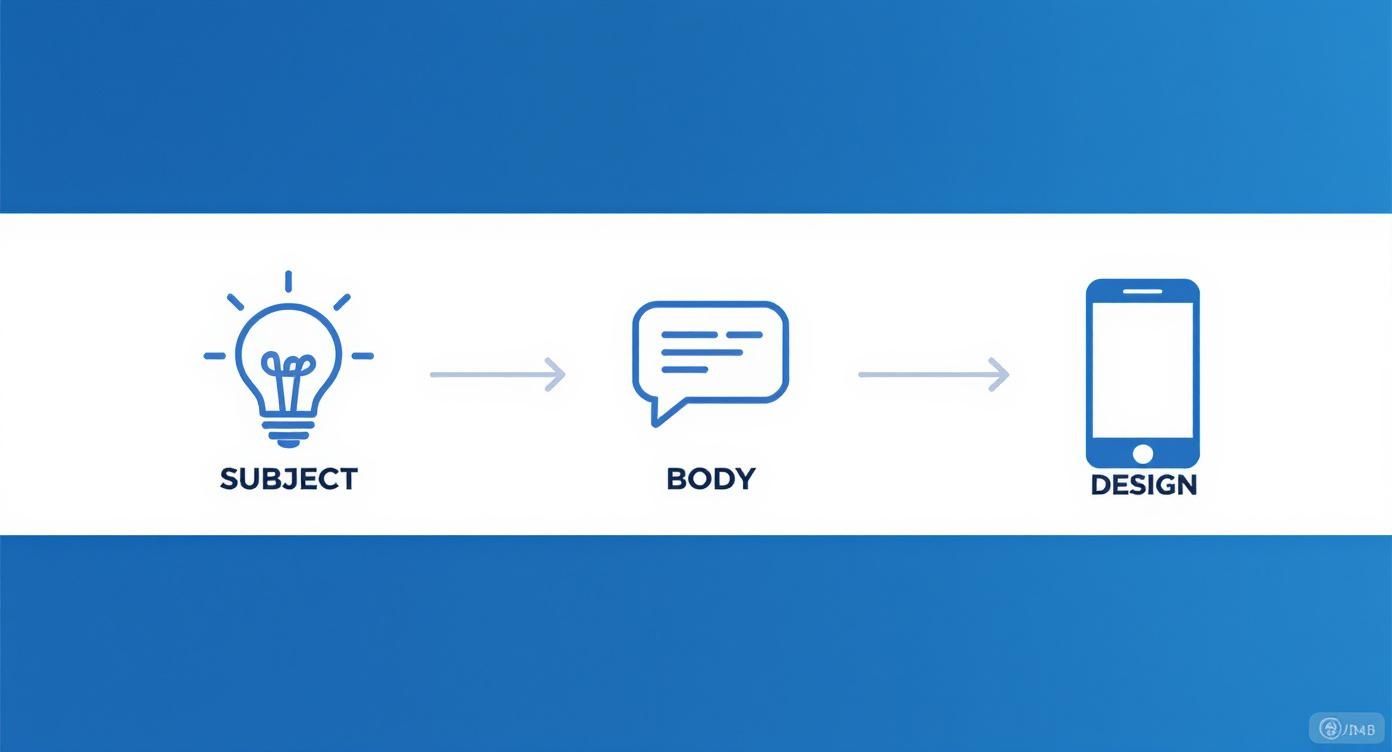
As you can see, a compelling subject line, genuinely helpful content, and a clean, mobile-friendly design are the three pillars of every great email you'll send.
This isn't just theory; the numbers back it up. Studies show that agents using automation see lead conversion rates jump by as much as 30% compared to those relying on manual follow-up. That's a huge difference, and it comes from the system's ability to nurture prospects consistently and at scale.
If you're ready to really dig in, exploring these powerful email marketing automation strategies can take your engagement to the next level. By setting up these core workflows, you’re not just sending emails—you're building a reliable system that grows your business around the clock.
Answering Your Top Real Estate Email Marketing Questions
Once you start moving from theory to practice, you'll inevitably bump into a few questions. That's a good thing—it means you're actually doing the work! This section is designed to tackle the most common hurdles I see agents face, with practical answers to get you unstuck and moving forward.
Think of this as your go-to cheat sheet for navigating those real-world challenges, from choosing the right tech to figuring out the perfect sending schedule.
How Often Should I Actually Email My List?
Ah, the golden question. And the honest-to-goodness answer is: it completely depends on who you're talking to. There’s no magic number that works for every contact in your database. A daily email with new listings might be a godsend for a motivated buyer, but it's just noise to a past client who settled in two years ago.
The real key is to match your cadence to their needs and where they are in their journey.
- Active Buyers & Sellers: These folks are in the thick of it. They want information, and they want it now. Sending relevant updates 1-3 times per week is perfectly fine. Think new listings that fit their criteria, open house schedules, or important market shifts.
- Long-Term Nurture Leads: This is your "maybe someday" crowd. You want to stay on their radar without being pushy. A bi-weekly or monthly newsletter with general market insights, home maintenance tips, or community news hits the sweet spot.
- Past Clients: The goal here is simple: build loyalty and earn referrals. A monthly or quarterly check-in is plenty. A local market snapshot, a happy "home-iversary" message, or a guide to seasonal local events works beautifully to maintain that connection.
Here's the bottom line: always provide value. Before you hit send, ask yourself, "Does this email help or inform the person receiving it?" It's far better to send one fantastic, valuable email a month than four that are just okay.
What's The Best Email Marketing Software For Agents?
Getting bogged down by software choices is easy, but you don't need the most expensive, complicated system to get incredible results. For most agents, the decision really boils down to three things: how easy it is to use, whether it connects to your CRM, and what your budget looks like.
Here are a few solid options, broken down by need:
- If You're Just Starting Out: Platforms like Mailchimp or Constant Contact are fantastic. They have simple drag-and-drop builders and straightforward automation features, and they’re either free or very affordable for smaller lists.
- If You Already Have a CRM: Before you buy something new, check the tool you already use. Many real estate CRMs like Follow Up Boss or LionDesk have powerful email marketing features built right in. Keeping everything in one system is almost always the most efficient route.
- If You're an Advanced Marketer: Ready for more firepower? Tools like ActiveCampaign or ConvertKit offer sophisticated automation that lets you create complex campaigns based on user behavior (like what links they click or pages they visit).
My advice? Start simple. You can always level up to a more advanced platform as your list and your strategy grow.
How Do I Keep My Emails Out of the Spam Folder?
Landing in the spam folder is the ultimate nightmare—it tanks your open rates and can seriously damage your reputation with email providers. Thankfully, staying in the main inbox mostly comes down to good habits and common sense.
First and foremost, never, ever use a purchased email list. Seriously. They’re full of outdated addresses and spam traps that will get your domain blacklisted in a heartbeat. Build your list organically through your website, open houses, and networking.
Next, watch your subject lines. Avoid spammy trigger words ("Free!", "Act Now!", "!!!"), using ALL CAPS, or loading up on exclamation points. Keep it professional and focused on the value inside.
Finally, make unsubscribing ridiculously easy. Hiding that "unsubscribe" link is a huge red flag to services like Gmail and Outlook. A clear, one-click opt-out shows you respect their inbox, which, funnily enough, makes people less likely to leave. For more on this, check out some of the other real estate marketing articles on the Saleswise blog.
Ready to create expert-level emails and marketing content in seconds? Saleswise is an AI platform built just for real estate agents. Generate compelling listing descriptions, market updates, and entire email campaigns trained on top-producing agent materials, all grounded in live market data. Start your $1 seven-day trial and see how much time you can save. https://www.saleswise.ai
